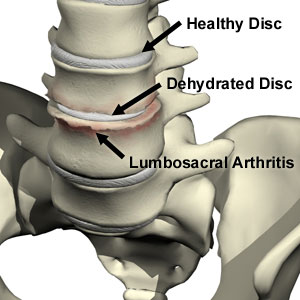|
Lumbosacral
Arthritis
Lumbar Arthritis or Lumbosacral Arthritis
Written by DynoMed.com,
Indianapolis, IN
Back pain is very common.
How many times have you lifted something that was too heavy and felt the
effects for days? Back pain is one of the leading causes of disability
and loss of work in the United States. Arthritis is one possible cause
of back pain.
Lumbosacral arthritis or lumbar
arthritis affects the lower back and pelvic area, causing pain, inflammation,
and the loss of motion in those areas. People with lumbosacral arthritis
should learn how to properly care for their backs. By using proper lifting
techniques, practicing a specific set of stretching and strengthening
exercises, and modifying activities to protect the backbone, people can
reduce low back pain. These actions may reduce the chance of increased
injury to the spine.
Causes of Lumbosacral
Arthritis
The exact cause of lumbar and lumbosacral arthritis is unknown. Some degeneration
of the spine is thought to be the result of the normal aging process,
but sometimes an old injury or a direct blow to the spine will play a
role. Also, people whose occupations require heavy lifting, long periods
of sitting or driving, or other repetitive pressures on the backbone are
also at risk for arthritis in this part of the spine.
Beginning at about age 20,
the discs of the spine begin to lose their elasticity and become dehydrated.
The lumbar discs become less supple and lose some of their height. This
alters the position of the vertebrae and the connecting ligaments, sometimes
leading to tears in disk tissue. With lumbosacral arthritis, the normally
soft discs between the vertebrae of the lower back gradually lose their
elasticity and their ability to cushion the bones effectively.
Symptoms of Lumbosacral
Arthritis
Pain, swelling and stiffness in the joints are the most common symptoms
of all types of arthritis. With lumbosacral arthritis, the pain may be
concentrated in the pelvic region or between the lower rib cage and buttocks.
Low back pain is associated with leg pain, numbness, tingling or
weakness in the legs. Often it results in an altered gait or a change
in posture. This can lead to pain in other weight-bearing joints such
as the knee, hip and ankle.

Your doctor may do several
different kinds of tests to determine whether you suffer from lumbosacral
arthritis or another type of arthritis or disease. He or she will examine
your spine and ask you for your medical history. Be sure to tell your
doctor about any ongoing conditions, such as heart disease or diabetes
and any old injuries. An X-ray may be ordered to look inside the bones
of the spine. MRI (magnetic resonance imaging) scans may be used to confirm
or locate soft tissue degeneration. If your doctor suspects rheumatoid
arthritis a blood test may be ordered.
Treatment
of Lumbosacral Arthritis
With proper treatment, the pain associated with lumbosacral arthritis
can be managed. Arthritis is chronic or long-term condition and you
may find that the pain will come and go. |
|
While many people with
chronic low back pain are tempted to limit their physical activity,
this is ill advised. You may find that you need to rest more frequently,
but exercise should become part of your daily regimen. By increasing
physical fitness, your back may become stronger and you may increase
your overall feeling of well-being. You should work with your doctor
or physical therapist on developing an exercise program designed
to strengthen your lower back. You may also benefit from posture
training.
|
 |
| Some people
may occasionally need assistive devices, such as a cane or walker,
to help them walk. Braces or corsets may be used to reduce the motion
of the back. Sleeping on a firm mattress and sitting in a good chair
with armrests and a high backrest are also advisable. Ultrasound,
heat, ice, and massage can be helpful when treating lumbosacral arthritis.
|
|
|
Managing
your weight is also very important when treating this type of arthritis.
If you are above your ideal weight, you may be causing stress to
your back and making your condition worse.
Non-steroidal anti-inflammatory
medications (NSAIDs) are commonly used to manage pain. With lower
back pain, muscle relaxants may be prescribed occasionally but they
should be used with caution, as the risk of dependency exists. Sometimes,
in cases of extreme pain, a single treatment of a corticosteroid
epidural is injected directly into the affected area.
In rare cases, surgery
may be necessary after conventional therapy fails to manage the
pain. The decision is a tough one and needs to be carefully thought
through after consulting with an orthopedic surgeon and a neurosurgeon.
|
Surgery, using general anesthesia,
may be recommended. A technique known as a laminectomy is often used in
cases of spinal stenosis -- a condition related to arthritis of the spine
-- to widen the area available to the spinal chord. Sometimes, to stabilize
the lumbar region, two or more vertebrae are fused together. Surgical
procedures may include removing bony spurs and removing ruptured discs
pressing on nerves.

Your doctor can guide you in
choosing the most appropriate treatment for your lumbosacral arthritis.
|

